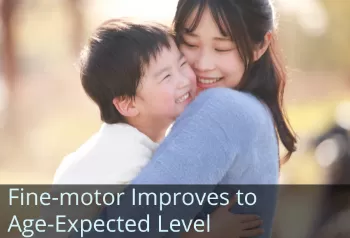Primitive Reflex Integration Case Studies
Parents and Therapist Impressed with 5-YO Boy’s Large Improvements in Short Time
Submitted by Kristen Furnari, MS, OTR/L

| Before | After |
|---|---|
| Delayed fine motor skills | Fine motor skills improved to age-expected levels |
| Struggled with attention | Attention greatly improved; able to participate in an adult-directed activity for 25 minutes |
| Difficulty with gross motor skills, specifically bilateral coordination and balance | Bilateral coordination is improved; able to complete jumping jacks, cross midline comfortably, and use non-dominant hand to stabilize paper or a toy |
| Struggled with impulsivity | Now much less impulsive |
Mario is a sweet 5-year-old boy who struggled with attention and impulsivity. I worked with him over a 12-week period with 1 session a week. When I first started to see Mario, he presented with delayed fine and gross motor skills, difficulty with bilateral coordination and balance, neck and shoulder tension while writing and completing fine motor tasks, and impulsivity. After talking to his family about his challenges at home and in community, I tested his primitive reflexes and noted ATNR [Asymmetrical Tonic Neck Reflex] and TLR [Tonic Labyrinthine Reflex] were significantly retained. Mario was unable to move his head without moving his body during testing.
Over the next 2 weeks, I introduced rhythmic movements to the family and started each session with completion of rhythmic movements. During the first week, Mario was able to tolerate each rhythmic movement for 5 seconds. I then taught the parent how to carry over these movements in the home. I quickly found out that the family was struggling to carry the movements out, due to not having hands on experience with me present. Therefore, I sat down with Mario and his family and had his mother practice the rhythmic movements prior to leaving that session. Within 2 weeks, Mario was able to tolerate 20 seconds of passive rhythmic movements [from the Brain and Sensory Foundations course] and his relaxation and enjoyment was observable during each movement.
After 2 weeks of rhythmic movements, I started to introduce ATNR and TLR playful movements with Mario. I chose to work on these two reflexes first, as this was where I saw most of his challenges during testing and learned from the course that it is recommended to integrate ATNR and TLR prior to working on STNR [Symmetrical Tonic Neck Reflex]. Throughout the session, Mario engaged in play activities [from the Brain and Sensory Foundations course] to work on integration . . . Parents demonstrated good carry over with the playful development home recommendations.
By week seven of working with Mario, I started to incorporate the 5-step balance process. We started each session with having Mario or his parent pick a goal for the day. Almost all of the goals were related to integrating the reflex and completing play activities related to the reflex. I then worked with Mario so that he can act out the goal. I found that since he was younger, he required more assistance then anticipated to act out the goal. For some goals, I provided light passive assistance to act out the goal. After, we would complete a playful activity that was related to reflex integration (one of the ones mentioned above).
When it came time for support repatterning, I initially attempted to have Mario complete this standing up. I quickly observed how difficult this was for him, as I saw him wandering off, trying to talk to mom, or struggling to engage. I changed my expectations and taught him how to complete this in a position lying down, which resulted in much better participation. By step 5, Mario almost always showed improvements with being able to engage in the goal or play activity afterward. I found the 5-step balance [from the Brain and Sensory Foundations course] easy to implement with him and the carry over very successful.
At the end of the 12 weeks, I found that Mario’s attention and impulsivity greatly improved from the first session. He was able to participate in an adult-directed activity for 25 minutes, his bilateral coordination improved, as he was able to complete jumping jacks, cross midline comfortably, and use his non-dominant hand to stabilize paper or a toy, and his fine motor skills improved to age expected skills. There was some tension still noted in his neck and shoulders during fine motor activities and some balance challenges still observed. However, parent verbalized how happy she was with his improvements in such a short time and confirmed that she felt comfortable with being able to carry over the learned material at home, to continue to work with Mario. As a clinician, I was not expecting such large improvements and growth in such a short time period, and was just as impressed and happy with Mario’s results.
(Edited, emphasis added)
*Disclaimer: The activities in the Brain and Sensory Foundations curriculum make use of the natural processes of neuroplasticity and development that are innately wired in the design of human beings to promote maturity and function. These activities appear to calm, organize, and mature the neuro-sensory-motor systems just as we see in the healthy development of human infants. Individual results may vary, and we do not claim to offer a diagnosis or cure for any specific condition or disorder. The Brain and Sensory Foundations activities appear to improve overall functioning resulting in measurable improvements for a range of conditions as demonstrated in over 1800 case studies from participants.

